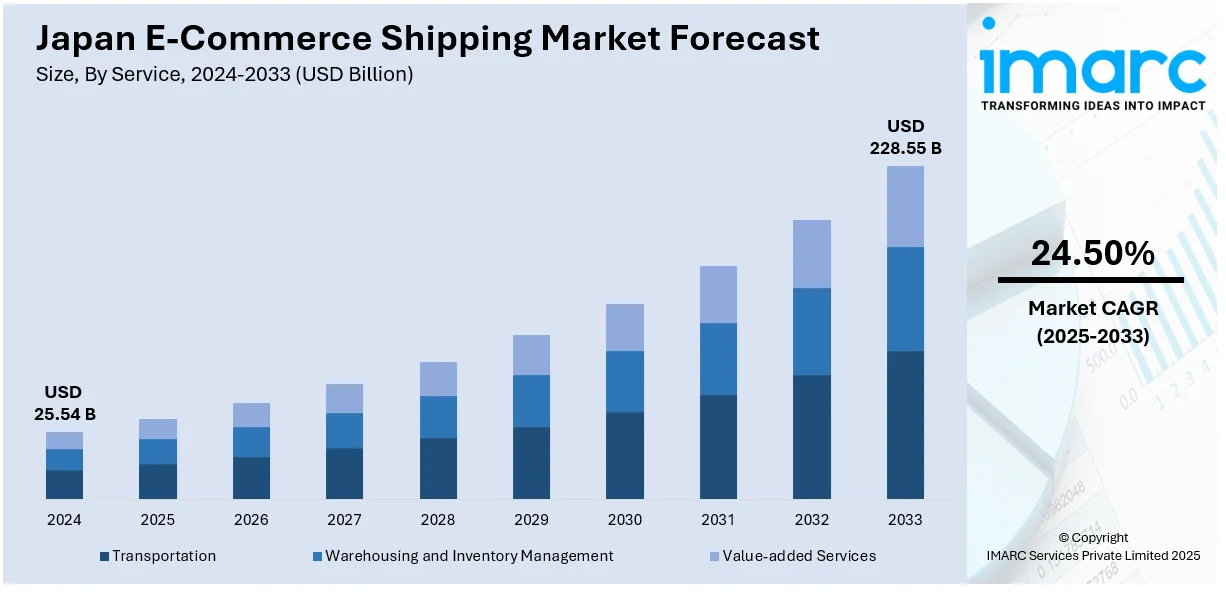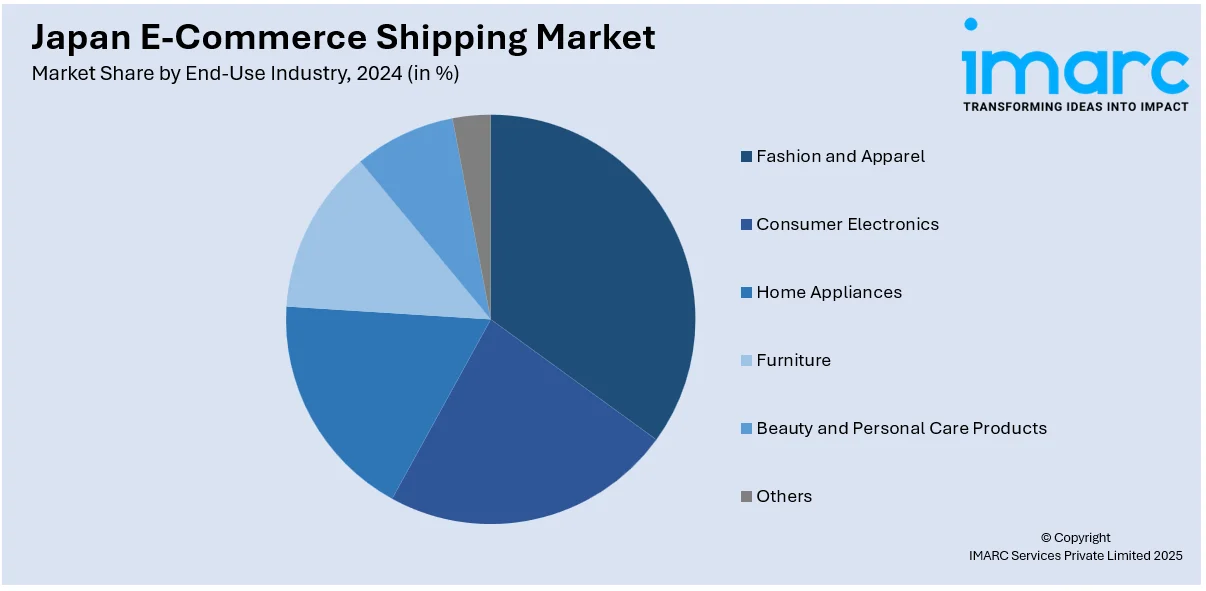
Japan E-Commerce Shipping Market Size, Share, Trends and Forecast by Service, Business, Destination, End-Use Industry, and Region, 2025-2033
Japan E-Commerce Shipping Market Overview:
The Japan e-commerce shipping market size reached USD 25.54 Billion in 2024. Looking forward, IMARC Group expects the market to reach USD 228.55 Billion by 2033, exhibiting a growth rate (CAGR) of 24.50% during 2025-2033. The market is driven by the increasing popularity of cross-border shopping and technological innovations in logistics. The adoption of automation and artificial intelligence (AI) in warehousing and delivery processes is enhancing operational efficiency. Additionally, improvements in cross-border shipping strategies to address the rising demand for fast, reliable deliveries is contributing to the expansion of the Japan e-commerce shipping market share.
|
Report Attribute
|
Key Statistics
|
|---|---|
|
Base Year
|
2024 |
|
Forecast Years
|
2025-2033
|
|
Historical Years
|
2019-2024
|
| Market Size in 2024 | USD 25.54 Billion |
| Market Forecast in 2033 | USD 228.55 Billion |
| Market Growth Rate 2025-2033 | 24.50% |
Japan E-Commerce Shipping Market Trends:
Rising Popularity of Cross-Border E-Commerce
With an increasing number of individuals in Japan opting for international vendors, the need for dependable and effective global shipping services is growing. E-commerce platforms and logistics firms are adapting by enhancing their global shipping strategies, providing competitive options for international delivery, and streamlining their management of customs and import taxes. This growth is also resulting in the creation of specialized shipping solutions designed for the intricacies of cross-border transactions, including personalized packaging and real-time tracking systems. A notable instance of this trend is Alibaba's introduction of "Tao" in 2024, a cross-border e-commerce platform aimed at Japanese buyers. Tao presented an extensive array of 3 million items, offering local payment and delivery assistance to enhance the international shopping experience for shoppers in Japan. The incorporation of regional payment options and effective delivery services demonstrates how e-commerce platforms are responding to the growing need for international shopping. By tackling the difficulties of international shipping, such platforms are enhancing Japan's shipping industry, facilitating cross-border transactions to be easier and more accessible for shoppers. This persistent emphasis on improving shipping options and increasing product availability is playing a major role in the Japan e-commerce shipping market growth.

Advances in Technology and Automation
Technological progress in logistics, especially automation and AI, is propelling the growth of the market. Automation in warehouses and distribution centers is lowering operational expenses while enhancing efficiency. Robotics and AI-driven technologies are essential in enhancing inventory control, order selection, and last-mile logistics. Predictive algorithms are utilized to enhance shipping routes, minimizing delays and increasing precision. To meet the rising client demand for quicker and more dependable deliveries, e-commerce firms are significantly investing in these technologies. A significant instance is the introduction of "Plus Shipping" in 2024 by Mitsui & Co. alongside Shopify Japan. This digital transformation solution aimed to optimize delivery processes for e-commerce businesses by connecting with prominent couriers, such as Japan Post, Sagawa, and Yamato. The service decreased shipping tasks by as much as 93%, allowing merchants to handle their logistics operations more easily and efficiently. By accommodating every package type and transportation method, "Plus Shipping" improved logistics processes, aligning with the growing trend of utilizing technology to fulfill increasing demands for swift, accurate deliveries. These advancements aid in handling significant order quantities while also increasing client satisfaction with better tracking features and quicker, more dependable delivery alternatives.
Japan E-Commerce Shipping Market Segmentation:
IMARC Group provides an analysis of the key trends in each segment of the market, along with forecasts at the country and regional levels for 2025-2033. Our report has categorized the market based on service, business, destination, and end-use industry.
Service Insights:
- Transportation
- Warehousing and Inventory Management
- Value-added Services
- Labeling
- Packaging
The report has provided a detailed breakup and analysis of the market based on the service. This includes transportation, warehousing and inventory management, and value-added services (labeling and packaging).
Business Insights:
- B2B
- B2C
A detailed breakup and analysis of the market based on the business have also been provided in the report. This includes B2B and B2C.
Destination Insights:
- Domestic
- International/Cross Border
The report has provided a detailed breakup and analysis of the market based on the destination. This includes domestic and international/cross border.
End-Use Industry Insights:

- Fashion and Apparel
- Consumer Electronics
- Home Appliances
- Furniture
- Beauty and Personal Care Products
- Others
A detailed breakup and analysis of the market based on the end-use industry have also been provided in the report. This includes fashion and apparel, consumer electronics, home appliances, furniture, beauty and personal care products, and others.
Regional Insights:
- Kanto Region
- Kansai/Kinki Region
- Central/ Chubu Region
- Kyushu-Okinawa Region
- Tohoku Region
- Chugoku Region
- Hokkaido Region
- Shikoku Region
The report has also provided a comprehensive analysis of all the major regional markets, which include Kanto Region, Kansai/Kinki Region, Central/ Chubu Region, Kyushu-Okinawa Region, Tohoku Region, Chugoku Region, Hokkaido Region, and Shikoku Region.
Competitive Landscape:
The market research report has also provided a comprehensive analysis of the competitive landscape. Competitive analysis such as market structure, key player positioning, top winning strategies, competitive dashboard, and company evaluation quadrant has been covered in the report. Also, detailed profiles of all major companies have been provided.
Japan E-Commerce Shipping Market News:
- In October 2024, JD Logistics announced the launch of express delivery services from China to Japan and South Korea. This expansion enhanced cross-border e-commerce logistics, aiming to boost trade flows and meet growing regional demand for faster delivery.
- In March 2024, Mitsui & Co. partnered with Shopify Japan to launch "Plus Shipping," a digital transformation service aimed at improving shipping for Japanese e-commerce businesses. The initiative enhanced logistics efficiency, client experience, and operational optimization.
Japan E-Commerce Shipping Market Report Coverage:
| Report Features | Details |
|---|---|
| Base Year of the Analysis | 2024 |
| Historical Period | 2019-2024 |
| Forecast Period | 2025-2033 |
| Units | Billion USD |
| Scope of the Report |
Exploration of Historical Trends and Market Outlook, Industry Catalysts and Challenges, Segment-Wise Historical and Future Market Assessment:
|
| Services Covered |
|
| Businesses Covered | B2B, B2C |
| Destinations Covered | Domestic, International/Cross Border |
| End-Use Industries Covered | Fashion and Apparel, Consumer Electronics, Home Appliances, Furniture, Beauty and Personal Care Products, Others |
| Regions Covered | Kanto Region, Kansai/Kinki Region, Central/ Chubu Region, Kyushu-Okinawa Region, Tohoku Region, Chugoku Region, Hokkaido Region, Shikoku Region |
| Customization Scope | 10% Free Customization |
| Post-Sale Analyst Support | 10-12 Weeks |
| Delivery Format | PDF and Excel through Email (We can also provide the editable version of the report in PPT/Word format on special request) |
Key Questions Answered in This Report:
- How has the Japan e-commerce shipping market performed so far and how will it perform in the coming years?
- What is the breakup of the Japan e-commerce shipping market on the basis of service?
- What is the breakup of the Japan e-commerce shipping market on the basis of business?
- What is the breakup of the Japan e-commerce shipping market on the basis of destination?
- What is the breakup of the Japan e-commerce shipping market on the basis of end-use industry?
- What is the breakup of the Japan e-commerce shipping market on the basis of region?
- What are the various stages in the value chain of the Japan e-commerce shipping market?
- What are the key driving factors and challenges in the Japan e-commerce shipping market?
- What is the structure of the Japan e-commerce shipping market and who are the key players?
- What is the degree of competition in the Japan e-commerce shipping market?
Key Benefits for Stakeholders:
- IMARC’s industry report offers a comprehensive quantitative analysis of various market segments, historical and current market trends, market forecasts, and dynamics of the Japan e-commerce shipping market from 2019-2033.
- The research report provides the latest information on the market drivers, challenges, and opportunities in the Japan e-commerce shipping market.
- Porter's five forces analysis assist stakeholders in assessing the impact of new entrants, competitive rivalry, supplier power, buyer power, and the threat of substitution. It helps stakeholders to analyze the level of competition within the Japan e-commerce shipping industry and its attractiveness.
- Competitive landscape allows stakeholders to understand their competitive environment and provides an insight into the current positions of key players in the market.
Need more help?
- Speak to our experienced analysts for insights on the current market scenarios.
- Include additional segments and countries to customize the report as per your requirement.
- Gain an unparalleled competitive advantage in your domain by understanding how to utilize the report and positively impacting your operations and revenue.
- For further assistance, please connect with our analysts.
 Request Customization
Request Customization
 Speak to an Analyst
Speak to an Analyst
 Request Brochure
Request Brochure
 Inquire Before Buying
Inquire Before Buying




.webp)




.webp)












